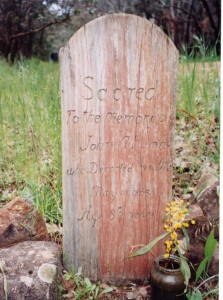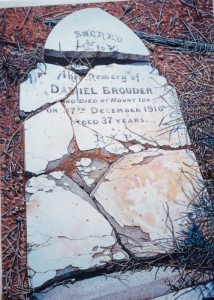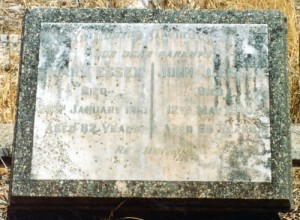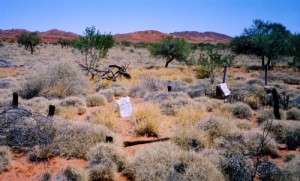Repair and Maintenance of Outback Graves
(By Yvonne Coate) In our vast State of Western Australia there are hundreds of old cemeteries and thousands of lonely graves - all landmarks in the development of our country. The general humble standard of many old graves was indicative of the deprived conditions which prevailed in isolated regions, but all have valuable heritage significance. In many old gold mining ghost towns the cemetery is the only remaining landmark - all evidence of buildings having long been removed.
In some instances, what appears to be a lonely grave could be the last visible remnant of a burial ground. It is important that those who maintain or restore pioneer graves recognise the essential elements which give the site its character. Radical alteration of the original site is not a recommended conservation procedure. Care must be taken when tidying a cemetery not to over do it.
Do not discard broken pieces or replace old monuments with something new. One of the main causes of cemetery deterioration is man. Damage can be caused by well-meaning individuals attempting to set things right.
You can download a PDF copy of these tips here: ![]() Tips on the Repair and Maintenance of Outback Graves (22.25 KB)
Tips on the Repair and Maintenance of Outback Graves (22.25 KB)
Wooden Features
As there was no shortage of timber many pioneer graves had wooden markers. They varied in size and shape from a cross or upright slab to the double-bed shape, and craftsmen carved out the lettering of the inscriptions. The reason for so many unmarked graves today is due to weathering, bushfires, or termites. So avoid the use of wood in restoration work. Without regular maintenance wood absorbs moisture causing expansion, then sun heats the surface resulting in contraction and with continual buffeting by weather conditions, it soon rots away.
Metal Features
These vary from intricately designed galvanised tin to wrought iron in a variety of shapes, some showing craft skills of the local blacksmith. Some metals need protection against corrosion, and a routine application of fish oil or other preservatives will help. Wrought iron fence surrounds are sometimes painted silver, black or brown, but in drier regions they are best left alone.
Stone Features
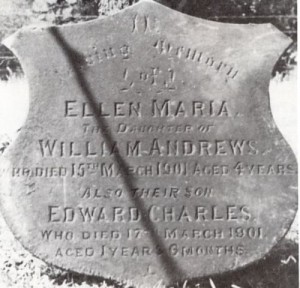 This includes local stone, sandstone, slate, granite, marble, quartzite, basalt, etc. Surface erosion and fretting are increased by dampness from the ground, overhanging tree limbs or fine wind-blown sand. Physical handling of stones may cause serious damage if cracks are developing. For restoration, do not use modem cement or plaster as they can react to stone or spoil the polish of some granites. Never use iron or steel dowels or clamps as they rust or expand causing cracking. It is best to repair cracked headstones by using bronze dowels. A monument suffering from rising dampness can be set on a concrete block above ground surface, but it is essential that the cement mix is waterproofed by using a waterproofing agent and the upper surface set on a slope in order to shed moisture. Storm water drainage should be considered.
This includes local stone, sandstone, slate, granite, marble, quartzite, basalt, etc. Surface erosion and fretting are increased by dampness from the ground, overhanging tree limbs or fine wind-blown sand. Physical handling of stones may cause serious damage if cracks are developing. For restoration, do not use modem cement or plaster as they can react to stone or spoil the polish of some granites. Never use iron or steel dowels or clamps as they rust or expand causing cracking. It is best to repair cracked headstones by using bronze dowels. A monument suffering from rising dampness can be set on a concrete block above ground surface, but it is essential that the cement mix is waterproofed by using a waterproofing agent and the upper surface set on a slope in order to shed moisture. Storm water drainage should be considered.
Broken Fragments
It is considered desirable wherever possible, that all monuments and symbols remain in situ on the grave. Broken fragments pieced together can be re-set with appropriate materials. Monuments should not be renovated without professional advice and work should not be carried out by inexperienced persons unless under supervision.
This image (left) is taken from a water colour painting by Ian Coate for the cover of Yvonne & Kevin Coates' book, "More Lonely Graves of Western Australia", which is available from Hesperian Press. Ian is the son of Yvonne and Kevin and is an accomplished artist and illustrator. Click the following to link to the Art and Illustrations of Ian Coate and the Lonely Grave book cover illustration
Moulds and Lichens
Where these are evidently covering the stone surface, they may be visually obtrusive. An organic poison could be carefully applied, allowing it to dry arid fall away, but professional advice should be sought. Never use a wire brush or scraper.
Tree Management and Weed Control
Historic plantings still in existence should be protected. Do not plant trees or shrubs on or alongside graves. Weed removal by well intentioned, but unskilled workmen using a mechanical blade to scoop up weeds in a confined space, removes grave mounds, stone outlines and metal numerical identification markers hidden beneath long grass. Invasive trees, shrubs or weeds on grave plots that cannot be removed without causing damage should be poisoned and left in situ to be removed later. Dry and overgrown vegetation presents a fire hazard.
You should always photographically record progress with before and after shots, because improvements become part of the overall history of the site. Many outback travellers carry a book on Western Australian lonely graves and their history.
When photographing lonely graves, if your camera does not automatically record the Geo-location, please make a note of the latitude and longitude (if you are able), or at least an accurate description of the distance and direction from the nearest town, roads and landmarks.
Yvonne & Kevin Coate
